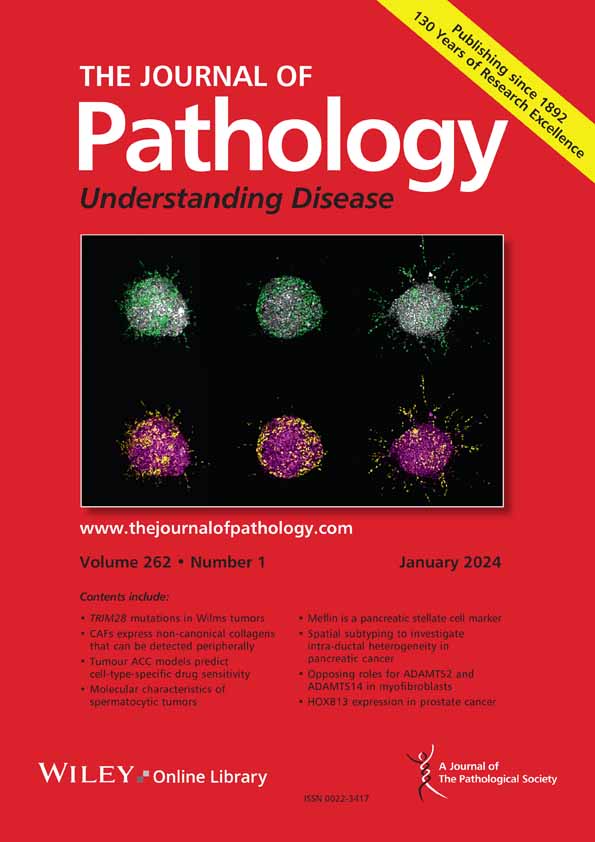Comprehensive characterization of micropapillary colorectal adenocarcinoma.
Ville K Äijälä, Jouni Härkönen, Tuomo Mantere, Hanna Elomaa, Päivi Sirniö, Vesa-Matti Pohjanen, Onni Sirkiä, Henna Karjalainen, Meeri Kastinen, Vilja V Tapiainen, Sara A Väyrynen, Petri Pölönen, Maarit Ahtiainen, Olli Helminen, Erkki-Ville Wirta, Jukka Rintala, Sanna Meriläinen, Juha Saarnio, Tero Rautio, Katri Pylkäs, Toni T Seppälä, Jan Böhm, Jukka-Pekka Mecklin, Anne Tuomisto, Markus J Mäkinen, Juha P Väyrynen
求助PDF
{"title":"Comprehensive characterization of micropapillary colorectal adenocarcinoma.","authors":"Ville K Äijälä, Jouni Härkönen, Tuomo Mantere, Hanna Elomaa, Päivi Sirniö, Vesa-Matti Pohjanen, Onni Sirkiä, Henna Karjalainen, Meeri Kastinen, Vilja V Tapiainen, Sara A Väyrynen, Petri Pölönen, Maarit Ahtiainen, Olli Helminen, Erkki-Ville Wirta, Jukka Rintala, Sanna Meriläinen, Juha Saarnio, Tero Rautio, Katri Pylkäs, Toni T Seppälä, Jan Böhm, Jukka-Pekka Mecklin, Anne Tuomisto, Markus J Mäkinen, Juha P Väyrynen","doi":"10.1002/path.6392","DOIUrl":null,"url":null,"abstract":"<p><p>Micropapillary colorectal adenocarcinoma is a morphologic subtype of colorectal cancer (CRC) with insufficiently characterized prognostic significance and biological features. We analyzed the histopathological, immunological, and prognostic features of micropapillary adenocarcinoma in two independent CRC cohorts (N = 1,876). We found that micropapillary adenocarcinomas accounted for 4.9% and 6.4% of CRCs in the two cohorts. A micropapillary growth pattern was associated with advanced stage and lymphovascular invasion (p < 0.001), but also with shorter overall survival independent of these factors and other prognostic parameters (Cohort 1: hazard ratio [HR] 1.76, 95% confidence interval [CI] 1.08-2.87; Cohort 2: HR 1.47, 95% CI 1.08-2.00). Multiplex immunohistochemistry and machine learning-assisted image analysis showed that the micropapillary growth pattern was associated with decreased CD3<sup>+</sup> T-cell and CD14<sup>+</sup>HLA-DR<sup>+</sup> monocytic cell densities. Molecular features of micropapillary adenocarcinoma were studied using bioinformatic analyses in The Cancer Genome Atlas (TCGA) cohort (N = 629) and validated with optical genome mapping and immunohistochemistry. These analyses revealed that micropapillary adenocarcinomas frequently present with chromosome region 8q24 copy number gain, TP53 mutation, and overexpression of UPK2, MUC16, and epithelial-mesenchymal transition involved genes, such as L1CAM. These results indicate that micropapillary colorectal adenocarcinoma is an aggressive morphologic subtype of CRC characterized by shorter overall survival, decreased antitumorigenic immune response, and unique molecular features. Our findings support the classification of micropapillary adenocarcinoma as a distinct, high-risk subtype of CRC, which should be systematically evaluated in patient care. © 2025 The Author(s). The Journal of Pathology published by John Wiley & Sons Ltd on behalf of The Pathological Society of Great Britain and Ireland.</p>","PeriodicalId":232,"journal":{"name":"The Journal of Pathology","volume":" ","pages":""},"PeriodicalIF":5.6000,"publicationDate":"2025-02-07","publicationTypes":"Journal Article","fieldsOfStudy":null,"isOpenAccess":false,"openAccessPdf":"","citationCount":"0","resultStr":null,"platform":"Semanticscholar","paperid":null,"PeriodicalName":"The Journal of Pathology","FirstCategoryId":"3","ListUrlMain":"https://doi.org/10.1002/path.6392","RegionNum":2,"RegionCategory":"医学","ArticlePicture":[],"TitleCN":null,"AbstractTextCN":null,"PMCID":null,"EPubDate":"","PubModel":"","JCR":"Q1","JCRName":"ONCOLOGY","Score":null,"Total":0}
引用次数: 0
引用
批量引用
Abstract
Micropapillary colorectal adenocarcinoma is a morphologic subtype of colorectal cancer (CRC) with insufficiently characterized prognostic significance and biological features. We analyzed the histopathological, immunological, and prognostic features of micropapillary adenocarcinoma in two independent CRC cohorts (N = 1,876). We found that micropapillary adenocarcinomas accounted for 4.9% and 6.4% of CRCs in the two cohorts. A micropapillary growth pattern was associated with advanced stage and lymphovascular invasion (p < 0.001), but also with shorter overall survival independent of these factors and other prognostic parameters (Cohort 1: hazard ratio [HR] 1.76, 95% confidence interval [CI] 1.08-2.87; Cohort 2: HR 1.47, 95% CI 1.08-2.00). Multiplex immunohistochemistry and machine learning-assisted image analysis showed that the micropapillary growth pattern was associated with decreased CD3+ T-cell and CD14+ HLA-DR+ monocytic cell densities. Molecular features of micropapillary adenocarcinoma were studied using bioinformatic analyses in The Cancer Genome Atlas (TCGA) cohort (N = 629) and validated with optical genome mapping and immunohistochemistry. These analyses revealed that micropapillary adenocarcinomas frequently present with chromosome region 8q24 copy number gain, TP53 mutation, and overexpression of UPK2, MUC16, and epithelial-mesenchymal transition involved genes, such as L1CAM. These results indicate that micropapillary colorectal adenocarcinoma is an aggressive morphologic subtype of CRC characterized by shorter overall survival, decreased antitumorigenic immune response, and unique molecular features. Our findings support the classification of micropapillary adenocarcinoma as a distinct, high-risk subtype of CRC, which should be systematically evaluated in patient care. © 2025 The Author(s). The Journal of Pathology published by John Wiley & Sons Ltd on behalf of The Pathological Society of Great Britain and Ireland.


